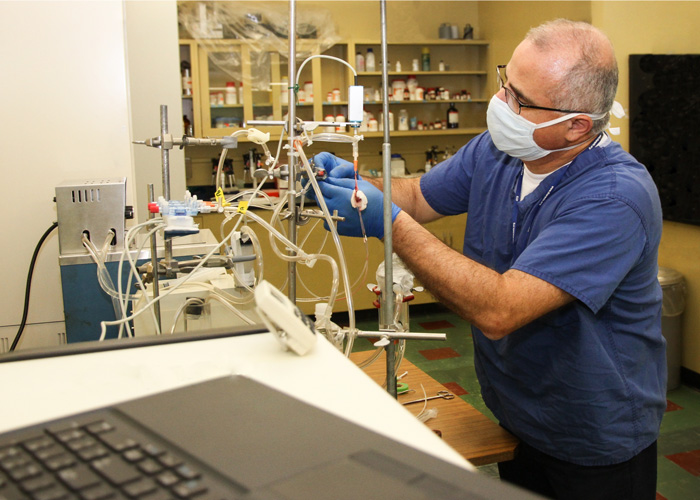Wolfe Dissertation Abstract
Evaluation of a porous polyester urethane scaffold seeded with highly adherent endothelial cells for use as a small-diameter tissue engineered vascular graft (TEVG)
Dissertation Date: July 20, 2023
Treatment for advanced coronary artery disease often involves surgical intervention with coronary artery bypass grafting (CABG). Autologous vessel grafts are the current option for CABG procedures, yet many patients with severe disease do not have healthy arteries or veins that can be used for autologous grafts. Further, autologous vessel harvest requires additional surgery, longer recovery, and increased risk of complications or infection. Current synthetic small-diameter vascular grafts (<6 mm diameter) are not suitable due to unacceptable patency rates. Loss of patency mainly results from a lack of an endothelial cell monolayer to prevent platelet activation, thrombosis, and neointimal hyperplasia. Although many groups have attempted to endothelialize synthetic grafts, most seeded endothelial cells are lost after implantation upon exposure to fluid shear stress (SS) from flowing blood. The mechanism driving endothelial cell loss is not entirely understood. Thus, there is an urgent clinical need for a small-diameter vascular graft that remains patent.
Tissue engineered vascular grafts (TEVGs) aim to recapitulate the properties of native blood vessels and overcome the limitations of current synthetic options. Critical considerations for a successful TEVG include high biocompatibility, adequate burst pressure strength, compliance close to the native vasculature, resistance to thrombosis and infection, and maintenance of patency long-term. TEVGs that contain a living endothelium may provide the long-term patency required for small-diameter applications. The overall goal of this project was to develop a small-diameter TEVG with a stable endothelial cell monolayer. This dissertation describes the evaluation of a polyester urethane scaffold seeded with highly adherent endothelial cells for use as a small-diameter TEVG. The work is divided into 3 aims: 1) Characterize a nanofiber biomaterial incorporated with cells and growth factors 2) Develop and test a novel method to increase the adhesion of endothelial cells to a biomaterial 3) Evaluate a small-diameter TEVG in vitro using a perfusion bioreactor system
Electrospun scaffolds are commonly used in tissue engineering applications, including in the fabrication of TEVGs. However, cell infiltration into electrospun scaffolds is usually limited by the small pores that result from the densely packed nanofiber architecture produced by electrospinning. One approach to increase porosity of electrospun scaffolds involves adding a sacrificial substance to create space or pockets for cells to penetrate. Here, we use polyethylene oxide (PEO) as a porogen to induce larger pores throughout an electrospun scaffold made of a biodegradable elastic polymer, polyester urethane. The porous and non-porous polyester urethane scaffolds were cultured with interstitial fibroblasts in a perfusion system and assessed for cell infiltration, graft compliance, graft burst pressure, and mechanical strength. The porous scaffolds exhibit significantly greater infiltration of cells compared to scaffolds without the addition of PEO. The porous polyester urethane scaffolds seeded with interstitial fibroblasts provide adequate mechanical and elastic properties to serve as a TEVG.
To improve the adhesion of endothelial cells within the graft, we first sought to determine if endothelial cell loss is a random process and whether it is possible to predict which endothelial cells in a population are more likely to remain adherent. In initial studies, we identified a subpopulation of endothelial cells that are more likely resist detachment upon exposure to fluid SS in vitro. We hypothesize that differential expression of genes involved in cell adhesion pathways allows the endothelial cells in the adherent subpopulation to remain adherent. Using bulk RNA-sequencing, we investigated the transcriptome of adherent endothelial cells compared to the whole population to identify targets for improving adhesion. We demonstrate that fibronectin leucine rich transmembrane protein 2 (FLRT2) can be used to select for the highly adherent endothelial cells in a population using fluorescence activated cell sorting (FACS). Sorted endothelial cells expressing low levels of FLRT2 show enhanced retention on both tissue culture plates and vascular grafts when exposed to fluid SS in vitro. This novel and innovative sorting approach is a promising method for seeding a small-diameter TEVG only with the endothelial cells that are more likely to remain adherent upon exposure to circulating blood. Future work will investigate retention of sorted endothelial cells in vivo using a pre-clinical large animal model.
Return to Dissertation Schedule


